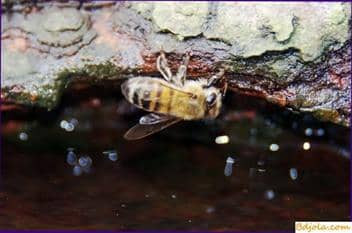
Bees eat liquid food, and the water available in honey completely satisfies their need, until they perform no work (in autumn, in winter). However, during the growing of larvae, the need for water increases. If bees bring a lot of nectar from plants, then the need for water is met by the available in nectar. If bees feed in this period with stocks of honey, then they bring water from the field.
In the family there are bee-water-beaks-these are the oldest bees that can not fly far and collect nectar. For one time the bee brings about 40 mg of water. In the family there are still bees-reservoirs to which water-carriers transmit water. The latter contain water in their honeyed cinders in a slightly sweetened form. They are inactive, sitting on the combs near the brood. As necessary, bees-tanks give water to other bees through the proboscis. After consuming all the water, the bees-tanks again take water from the bee-aquifers.
Strong bee family during the intensive brood rearing brings 40-50 g of water per day. With the appearance of honey collection, the number of bees-water-carriers decreases, the number of bee-tanks decreases, and when bees of nectar, 0.3-0.5 kg, bees cease to take water.
The inflow of water sharply increases in hot weather, when bees consume additional water for its evaporation and a decrease in temperature in the nest. On hot days bees make up to 200 g of water a day, which is suspended by small droplets into empty cells near and between cells with brood. Evaporating, water increases the humidity of the air and simultaneously reduces its temperature (heat is expended on evaporation).
Bees insistently look for water, flying out even in cool, windy weather; in such cases, a part of the bees freezes and dies. To prevent the death of bees and to facilitate their collection of water, special aprons for bees are placed in the apiary or next to it. A good drinking bowl should satisfy the following requirements: completely eliminate the possibility of death of bees in water, provide running water, well warmed by the sun; do not expend unnecessarily a lot of water.

Fig. 13. A drinking bowl for bees
These requirements are met by the drinking bowl, constructed from a barrel with a tight lid and built in the lower part by a crane with an inclined board. The faucet is opened so that water drips from it with the desired speed, sufficient to wet the board all along its length. On the board are cut out zigzag grooves 2 mm deep, which give the water current a certain direction. Warm water in the sun, flowing a thin layer, the bees are willingly taken away.
Under the end of the board, designed for water drain, dig into the ground a second barrel without a bottom so that the water remains soaked in the soil, and not spilled over its surface.
If necessary, to economically spend water, you can arrange a drinking bowl from a bottle and a baking tray. A bottle of water is attached in an inverted form on the counter above the baking tray so that its neck is lowered into the water. Over the water in a baking tray put floats or plywood with holes through which the bees take water. As the water is spent in the baking tray, it comes from the bottle.
Drinking water is installed in a sheltered from the wind in a sunny place. In open spaces it is fenced off with a low fence. On cool days in the spring, it is desirable to pour water into the drinker, warmed in a warm room.
Bees in the spring very willingly take water with a small admixture of table salt (5 g per 1 liter of water). In one experiment, small troughs with water from different sources – river, rain, well, with the addition of table salt, etc. – were exposed in the apiary. Observations showed that 48% of the bees took rainwater and 52% – salted water. When 8 g of salt was added to 1 liter of water, the number of bees on drinkers decreased, and when 10 grams of salt was added to 1 liter of water the bees refused to take it at all. With repeated counts, this ratio was constantly preserved. Consequently, bees in the spring need both pure water (better soft, without salt impurities), and in salted water.
In other experiments it was found that the admixture of table salt in the bee’s forage stimulates the release of wax. Therefore, on large apiaries it is advisable to put two drinkers – with clean and salted water. To do this, on a wide board you can make two parallel grooves, in which water (pure and salty) would come from two adjacent barrels.
Пасека в августе. Технологии пчеловождения в лежаках.
Feeding base of beekeeping